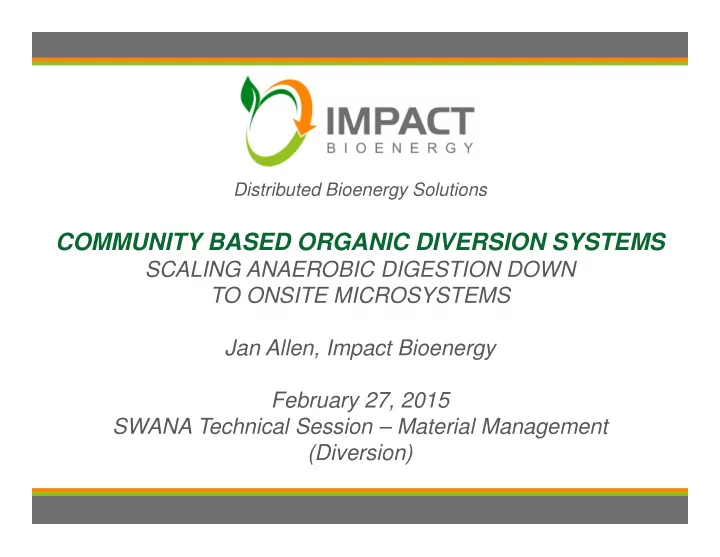

Distributed Bioenergy Solutions COMMUNITY BASED ORGANIC DIVERSION SYSTEMS SCALING ANAEROBIC DIGESTION DOWN TO ONSITE MICROSYSTEMS Jan Allen, Impact Bioenergy February 27, 2015 SWANA Technical Session – Material Management (Diversion)
Distributed Bioenergy Solutions Onsite systems typically serve small and medium sized facilities, communities, and organizations with 50 – 50,000 people. They can save resources in a number of powerful ways: saving money for disposal, energy, landscape, and food simultaneously. • Elimination of hauling and disposal of foodwaste, foodservice paper, landscape waste, and woodwaste. • Creation of renewable energy onsite. • Creation of new soil, fertilizer, and sequestered carbon for landscaping, horticulture, and food crop production – at a local and community scale.
The Power of Onsite Systems Food Production Energy V. Fuel + Heat + Electricity Bioconversion A. Digestion + Composting + Gasification
Food Hub Example
Organizations with Bioenergy Potential Restaurants US & CA 699,600 Educational Campuses US & CA 4,000 US Military Bases US 525 Communities over 50,000 US & CA 443 Convention Centers US & CA 281 Zoos US & CA 251 National/Provincial Parks 200 Destination Ski Resorts US & CA 73 Major Islands US & CA 29 Major Island Nations Caribbean 13 Unadjusted Subtotal 705,415 Adjusted Onsite Potential 285,000
Farm-to-Table Facts • Urban farming and community gardening is blossoming in North America. – In one city a population of 650,000 supports 88 community gardens, 31 acres of food production, and 6,000 active gardeners. • Farm-to-table businesses, slow-food projects, and 100- mile-diets are all part of community supported agriculture. – These programs are also expanding. • Some operating precepts: Food to renewable energy to soil to new food Consumers (you) are making a choice to be an active, proactive, and informed part of the food chain.
Benefits of Bioenergy • Supply onsite building heat, hot water, lighting, electricity, and/or vehicle fuel to host facility or adjacent properties • Managing organic waste on the property ` – ( minimizing the export of waste materials) • Connect with urban agriculture and renewables movements – ( minimizing the import of manufactured and processed food ) • Increase system diversity and reliability by deploying a local, distributed renewable energy system – ( minimizing the import of energy and fuel ) • Build jobs and commerce within the community – ( minimizing the export of dollars )
Model 185 – NAUTILUS 111,000 - 555,000 BTU/hr
Model 185 – NAUTILUS 185 = 0.5 TPD 185-2 = 2.5 TPD
Model 25 – HORSE High-solids Organic-waste Recycling System with Electrical output 15,000 BTU/hr 36 kWh per day + 1.2 therms heat per day
Model 25
Model 25 – System Details • Food, Paper, Grass, Liquids Recycling • 130 square feet • 0.36MMBTU per day gross energy output (360,000 BTU/day) • 2.5 kW per hour electric output (generator shown at right) • 175 cubic feet of gas storage (expanded storage is available as an option) • 135 lbs. per day input rate • 12 volt surplus gas burner safety system
Model 25 – Fabrication
Model 25 – Fabrication
Onsite System Capacity Chart Model Name Lbs. per day Tons per day Tons per month Tons per year HORSE AD 25 135 0.1 2.1 25 NAUTILUS AD 185 1,015 0.5 15.4 185 NAUTILUS AD 185-2 5,075 2.5 77.2 926 AD 1000 5,482 2.7 83.4 1,000 AD 5500 30,135 15.1 458.3 5,500 AD 1000 and 5500 are expandable to 2X of rates shown
Onsite System Energy Yield Chart Model Name BTU per hour BTU per day HP: 24-7 basis gross MWh/day HORSE AD 25 15,000 360,000 6 0.11 NAUTILUS AD 185 111,000 2,664,000 44 0.78 NAUTILUS AD 185-2 555,000 13,320,000 218 3.90 AD 1000 660,000 15,840,000 259 4.64 AD 5500 3,300,000 79,200,000 1,295 23.19 All rates are expressed as full capacity maximums
Example: Greenerzone BC • Service area population of about 150,000 – Langley BC area • Enterprise Curbside Organics Collection – – Private Contractor – Approximately 36,000 kg/year diverted from disposal – Potential to divert 100,000 kg/year from disposal • Extracting Energy – HORSE Bioenergy System • Converting Organics to Soil Products – CITYPOD, Dehydration, Vermicomposting and Field Composting • Partnering with Field and Hothouse Growers • Partnering with Vermicomposting, Urban Food Hubs
Greenerzone BC The HORSE can save resources in a number of powerful ways by saving: money for disposal, energy, chemical inputs to the landscape, and costs for food simultaneously. • Elimination of hauling and disposal of foodwaste, foodservice paper, landscape waste, and woodwaste. • Creation of renewable energy onsite PLUS creation of new soil, fertilizer, and sequestered carbon for landscaping, horticulture, and food crop production at a local and community scale, PLUS • Cost Savings and reasonable ROI • Quick Deployment • Low Capital Cost • Scalable Design • Odor Control • Easily marketable biocarbon products
Example: Zero Waste Vashon • Island population of about 10,000 – King County WA • 501 c 3 Non profit – Focus on organic waste which can be better managed and processed. Goal of ZWV to honor green materials as a resource. Organic waste should be converted locally in an island-located facility. – Complementary technologies include anaerobic digestion, passive and active solar, biosolids, and biochar. – Approximately 8,000 tons/year currently exported to landfill disposal. – Potential to divert about 5,000 tons/year in an island-located facility. • Extracting Energy – AD • Converting Organics to Soil Products – Composting and Wood Gasification • Co-locating Field and Hothouse Food Production
What Are the Success Factors? � Cost Savings and reasonable ROI � Quick Deployment � Low Capital Cost � Scalable Design � Odor Control � Easily marketable biocarbon products
Thank You Jan Allen jan.a@impactbioenergy.com 206.250.3242 Biogas Lighting!
Recommend
More recommend